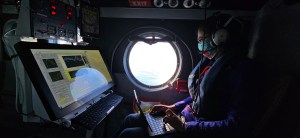Earth Science Research News
Earth News and Information
Filters

In autumn 2024, California’s Monterey Bay experienced an outsized phytoplankton bloom that attracted fish, dolphins, whales, seabirds, and – for a few weeks in October – scientists. A team from NASA’s Ames Research Center in Silicon Valley, with partners at…

Editor’s note: NASA’s Arcstone lunar calibration instrument lifted off aboard the Transporter-14 rideshare mission with SpaceX via launch integrator Maverick Space Systems from Vandenberg Space Force Base in California on June 23, 2025 at 2:25 p.m. PT. NASA will soon launch a one-of-a-kind instrument, called Arcstone, to…

NASA uses satellite lidar technology to study Earth’s forests, key carbon sinks.

UPDATE June 30, 2025: The second rocket of the SEED mission launched on Saturday, June 28, at 8:11 p.m. Marshall Islands Time (MHT). Principal investigator Aroh Barjatya reports that the rocket launched into active science conditions in the ionosphere and…

Science in Space June 2025 Scientists use instruments on the International Space Station to study phenomena in Earth’s ionosphere or upper atmosphere including thunderstorms, lightning, and transient luminous events (TLEs). TLEs take many forms, including blue jets, discharges that grow…

NASA’s Earth science missions have continued to demonstrate remarkable adaptability and innovation, balancing the legacy of long-standing satellites with the momentum of cutting-edge new technologies. The Terra platform, the first of three Earth Observing System flagship missions, has been in…

NASA’s Ames Research Center in Silicon Valley houses a unique laboratory: the Airborne Sensor Facility (ASF). The engineers at the ASF are responsible for building, maintaining, and operating numerous instruments that get deployed on research aircraft, but one of their…

Introduction Tropical cyclones represent a danger to life, property, and the economies of communities. Researchers who study tropical cyclones have focused on remote observations using space-based platforms to image these storms, inform forecasts, better predict landfall, and improve understanding of…

Editor’s note: The caption for the OPERA portal image of uplift in the Gulf of California was updated on June 25, 2025. An online tool maps measurements and enables non-experts to understand earthquakes, subsidence, landslides, and other types of land motion.…

Introduction On September 15, 2018, the NASA Ice, Cloud, and land Elevation Satellite-2 (ICESat-2) mission launched from Vandenberg Air Force Base and began its journey to provide spatially dense and fine-precision global measurements of Earth’s surface elevation. Now in Phase…






















